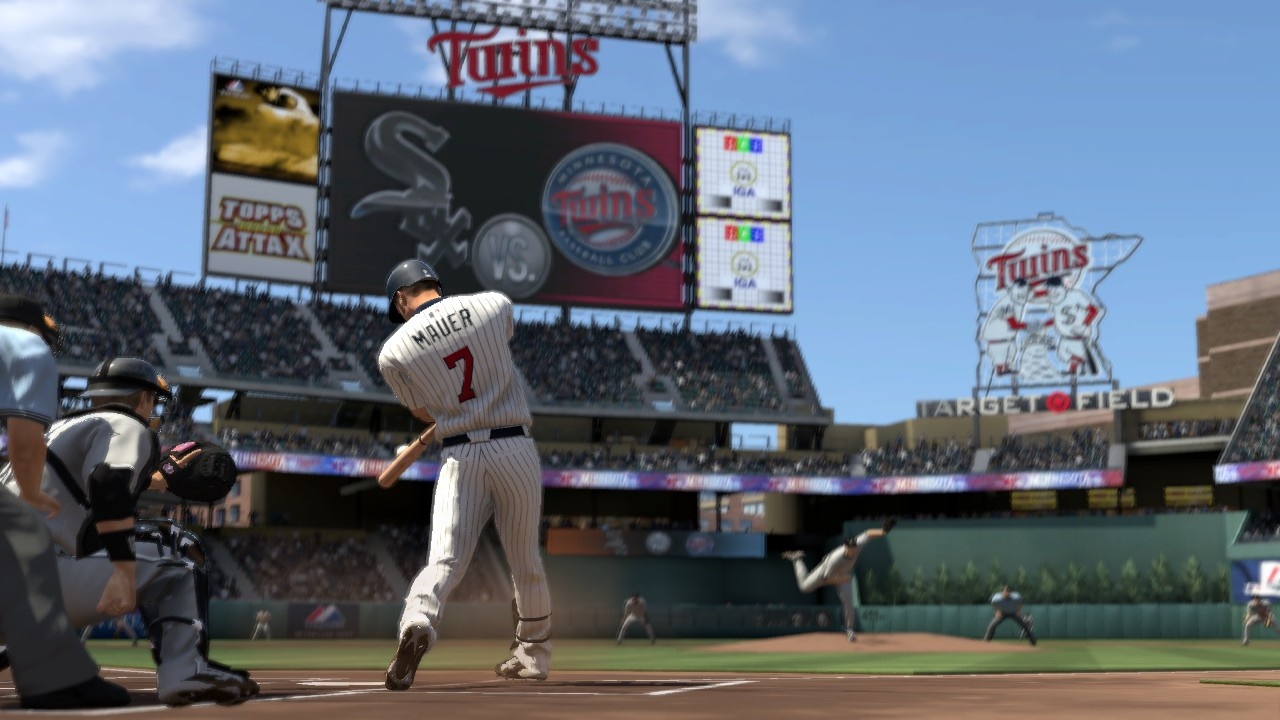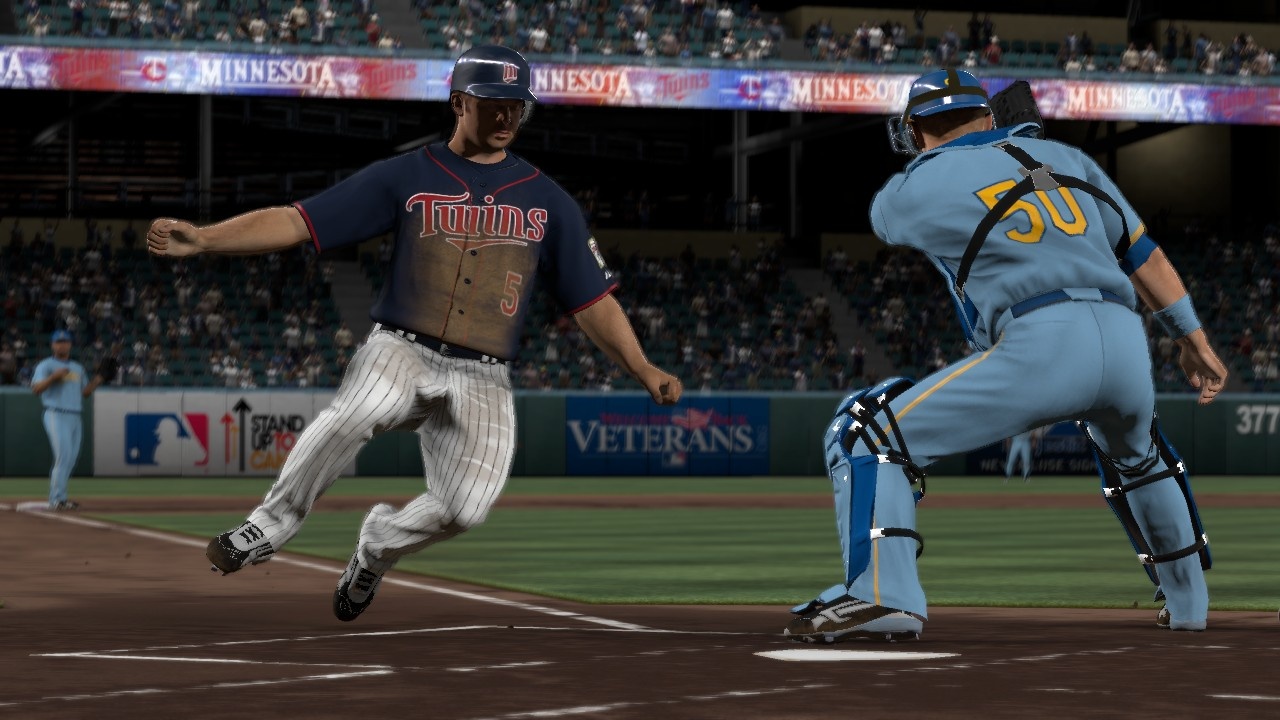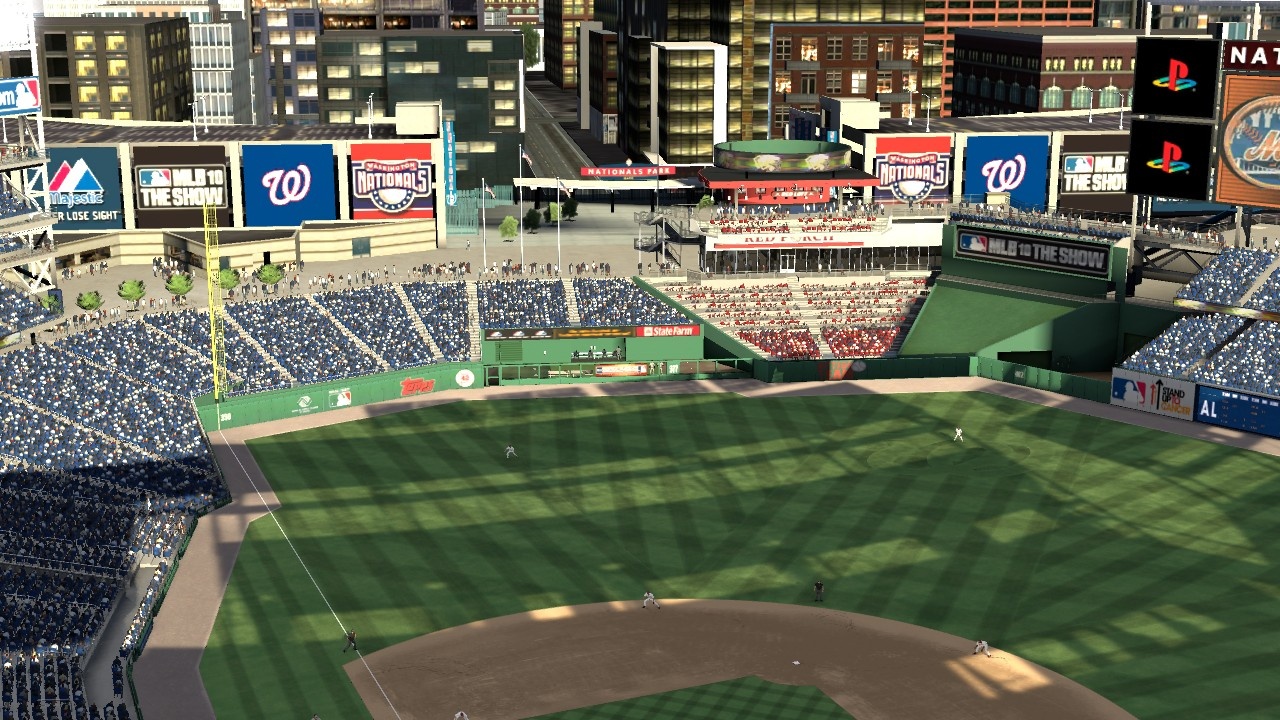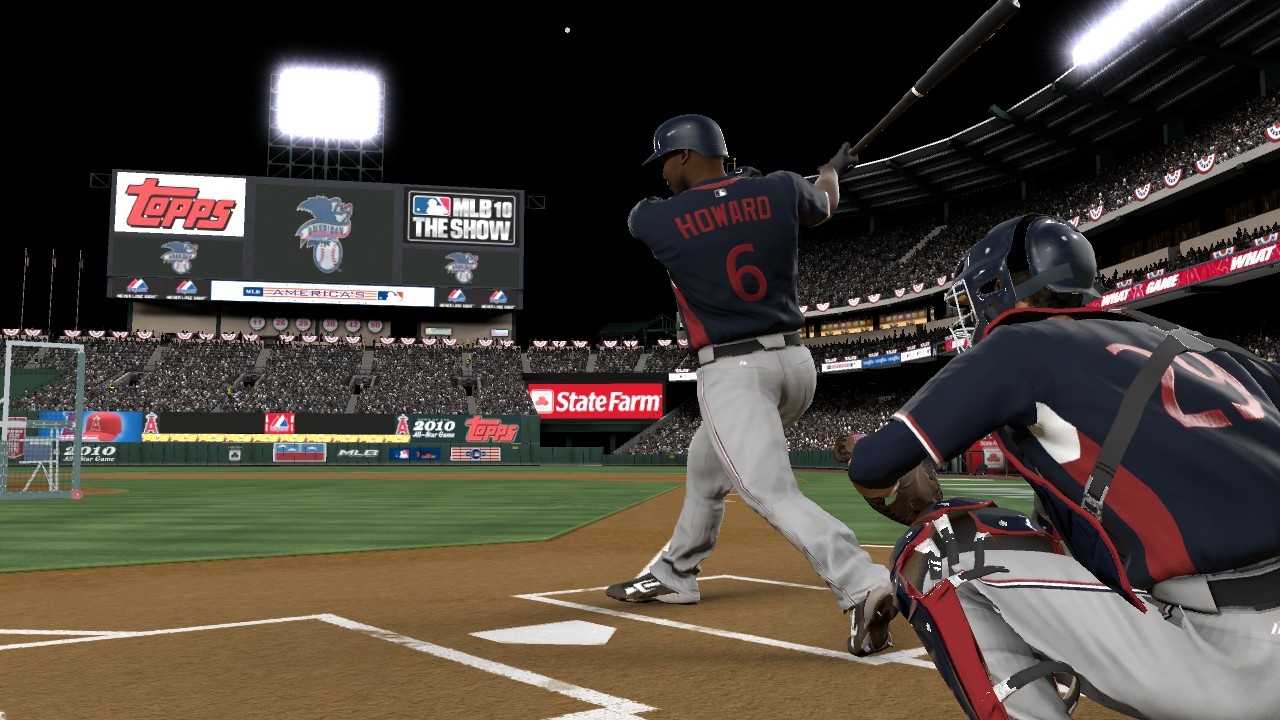Let's get this out of the way right off the bat: MLB 10: The Show is still the undisputed champ in baseball games. On-field realism, spectacular broadcast presentation values, and attention to little details--right down to the scowl on Kevin Youkilis' face--make this a great achievement sure to warm the hearts of everyone who's had Opening Day circled on the calendar since January 1. But it's still hard not to be disappointed. This year's game is almost exactly the same as its predecessor, with no significant changes to the gameplay. This is an undeniably great franchise, although it is also in a holding pattern, with the current game mainly delivering the goods despite seeming creaky in a few areas. It is most notable when it comes to pitching, but it's also a fair bit buggy in others areas, especially the online multiplayer.

Just about everything in MLB 10 was also front and center in MLB 2009. All of the modes of play are back for another kick at the can, including the headlining Road to the Show mode where you role-play a scrub from the minors to major league glory. There's also Exhibition, Season, Franchise, Manager, Rivalry, online ranked matches, and league play. Some of these features have been expanded, but nothing has changed in a dramatic way. You can now run full online season leagues. New options have been introduced for pick-off attempts, so you can snap throw or lazily toss the ball over to keep the runner honest. Subbed-in pitchers now have the option of taking warm-up throws. All-Star week during seasons has been jazzed up with the playable futures game and home-run derby. New camera angles give the diamond action even more of a game-of-the-week TV sheen. In-game video clips can be collected and edited into personal highlight reels. Recording your own stadium cheers and jeers is possible for anyone with a USB microphone. There are a few new minor-league parks to keep the scenery varied if you get stuck on the farm in Road to the Show. Stats generated during franchise play seem even more accurate than before, to the point that the game could likely be used as a great prognosticating tool for the real upcoming MLB season. You get the picture. Nothing here dramatically alters the way that the game plays, at least not in any way that will make you sit up and take notice.
Road to the Show 4.0 probably got the lion's share of the attention from the developers, with new options like the ability to watch entire games pitch by pitch and call full games when playing a catcher. Training is a sweet addition, giving you the chance to improve your skills through such workouts as taking cuts in the batting cage and pitching simulated games. This can be a huge help in the early stages when you're struggling to escape riding the buses in AA. Neither of the latter options is likely to see a whole lot of use, though, because both are for truly hardcore fans. Few players will have the time to watch entire games. And you just aren't given enough to do to stay interested when calling games behind the plate. It's a lot like pitching because you pick the type of pitch and location but without the challenge of actually having to work the meter to deliver the ball. The biggest issue with Road to the Show has always been the numerous pauses when loading or saving between games, and that hasn't been addressed at all this year. If anything, these delays take even longer than ever, which drags everything out so much that it feels like you spend more time looking at loading and saving screens than you do actually playing games. This is particularly true if you're controlling a position player who just takes four or five at-bats per game along with a handful of fielding attempts. Road to the Show really grabs you when you're playing a starting pitcher; if you're playing a third baseman, it's awfully slow unless you're really into the whole role-playing thing. You've got to be seriously committed to take the time to get any sort of position player to the bright lights of a big-league stadium.
Out on the diamond, though, MLB 10 can still take your breath away. The game is incredibly accurate in depicting the little things seen in baseball TV broadcasts, adding a ton of finer details that make the game look almost photo-realistic this year. Stadiums look absolutely spectacular. All of the arches and signage are where they should be, from little ads and fans sporting K signs in the crowd to big icons like the swinging neon Liberty Bell in Philadelphia's Citizen Bank Park. Shadows creep across the field at the close of day. Idiots fall onto the field reaching for foul balls down the lines. Mascots dance on top of dugouts between innings. Animations have been added so that you never have to watch the centerfielder throw the ball in to second the same way twice. Fireworks now go off after home wins and beach balls bounce around in the stands. All of this builds a truly incredible baseball party atmosphere, with every contest playing out like a game for the ages broadcast and preserved on high-def TV.

Player art is also superb. Along with being able to recognize big-league faces from C.C. Sabathia to Doc Halladay, you can spot changing expressions depending on what's taking place on the field. Victims of called strikeouts never leave the plate without a few choice comments and grimaces. Stadium sounds are just as convincing. Crowd noise is boisterous, especially during rivalry games at key moments. When the Red Sox get rolling against the Yankees in Fenway, the crowd gets so cranked up that it drowns out the broadcasters. But that isn't entirely a bad thing, actually, because the booth trio of Matt Vasgersian, Dave Campbell, and Rex Hudler offers nothing but vague generalities about pitches, as well as dumb insults whenever you take a bad swing. Hudler is just flat-out annoying this year, spouting dumb catchphrases like "A rookie and a teabag have a lot in common--you never know what you've got until you put 'em in hot water" over and over. Unfortunately, it's hard to critique them too much because this trio is representative of what you get on most real MLB broadcasts these days. Similar brickbats can be hurled at the poor music soundtrack, which comprises mostly second-tier alt-rock acts. At least you can shut down these tunes or use the in-game audio features to replace it all with songs of your own, right down to picking songs for specific teams and walk-up music.
Gameplay remains remarkably true to life. Plays in the field are dead-on, such as the speed and range of players; how fast the ball moves; how the ball springs off the bat depending on the timing of the batter's swing; tremendous hit variety; and so on. About the only justifiable complaint is the number of times that a wild pitch or passed ball on a third strike results in the batter reaching first safely. This happens at least a couple of times during a game, which is far too frequent. Hitting is particularly right on. It has you using the same old mechanism of the left stick to aim the bat and the X button to take a cut, but it remains a genuine batting simulation. When you get real wood on the ball, you feel great satisfaction. When you get totally fooled and whiff way out in front of a change, you want to crawl under the nearest rock. Difficulty settings are also just right. Rookie lets you get your timing down, and then each subsequent step up forces you to use the left stick more to get good contact on the ball. With all that said, hitting is very challenging. You have to show an extreme amount of patience and take a lot of cuts in the practice-mode batting cage to have any real success in the big leagues.

Pitching is more problematic. While heading to the mound with the familiar old meter where you hit the X button to time your windup for release is authentic and challenging, there are some issues here that hurt the entire game. The computer now has an incredible eye and can foul off seemingly anything. If you get two strikes on a batter, he generally won't chase junk out of the zone and then starts fouling off anything close. At-bats get tougher when you get ahead on the count, which is the exact opposite of how they should evolve. Unless the batter puts the ball into play in the first two or three pitches, you inevitably get into a drawn-out battle that results in you throwing a good eight to 10 pitches. Because of this, solo games can easily stretch to 40 minutes or so. That's a very long time for a single contest, especially if you're pitching in a Road to the Show career or trying to play a fair chunk of a 162-game season in Franchise mode. Randomness is another pitching problem. You can nail your marks perfectly on the pitch meter and still wind up chucking one in the dirt or smoking the batter in the shoulder. This is understandable from a pragmatic perspective because no pitcher hits his spots all the time, even if his mechanics are solid. But in a game, this comes off as a dose of sheer chance that just winds up being unnecessarily frustrating. All in all, sacrificing a tiny bit of authenticity and challenge for speedier games with more control wouldn't be a bad trade-off.
Bugs are another matter. While there aren't a ton of issues here, there are far more than there should be for a game that hasn't been changed all that much during the past few years. Laggy online play via the SportsConnect feature is the biggest cause for concern. Constant quick hitches break the flow of games. When pitching, the meter frequently pauses just long enough to screw up your toss. At the plate, you often go from standing still with the bat on your shoulders to a shot of the ball rocketing into the outfield. In the field, you consistently stutter-step and miss balls, which results in a lot of unwarranted singles, as well as extra-base shots into the gaps. Not surprisingly, this results in a whole lot of frustration, along with some games that lag so much they're all but unplayable. At times, for instance, the pitching interface lags so much that it simply doesn't register commands at all. Other online flaws are also apparent. Sony has already acknowledged a bug with intentional walks where the game freezes after the free pass until somebody quits the game. Online players are already using this as an exploit to earn cheap wins. Hard system lockups that force you to manually restart your PlayStation 3 occur all the time when you come out of online games. The servers are also experiencing glitches, with SportsConnect occasionally being inaccessible and game results not being recorded correctly.

Other associated hiccups in the offline game are less impactful, though still obvious. CPU teams remain way too easy to fool on trades in Franchise play because holes are still present in the player-rating system. To build a team of all-stars, all you need to do is go to the trade screen and surf through other clubs until you get bites on whatever junk you've got to offer. It won't take long for you to scoop away enough talent to set up a modern-day Murderers' Row and a starting five of Cy Young candidates. Trades between computer-run teams are equally bizarre, especially when they involve older players. Seeing Derek Jeter dumped off for a package of mediocre prospects is guaranteed to break your suspension of disbelief. Some players should just be untouchable, particularly the all-time Yankee leader in hits. Computer-generated pitchers on AA/AAA teams in Road to the Show are equipped with a crazy number of pitch types and heaters that clock into the high 90s. This is totally unrealistic and makes for a rough ride in the early going if you've created a position player. It's a real relief just getting to the majors because, then, you finally get to take on some authentic pitching. And Tropicana Field seems to be very buggy in all modes of play, causing freezes during games played there when going to the bullpen.
It's not hard to level complaints at MLB 10: The Show, but that's because the fundamentals of the game are so good that the bad points really stand out. There is room to make things better, especially given the online bugs, issues with pitching, problems with computer batters, and the too-long load times in Road to the Show. Nevertheless, this is still a great game that gets both the big and small pictures largely right, as well as presents a portrait of baseball that is uncannily realistic.